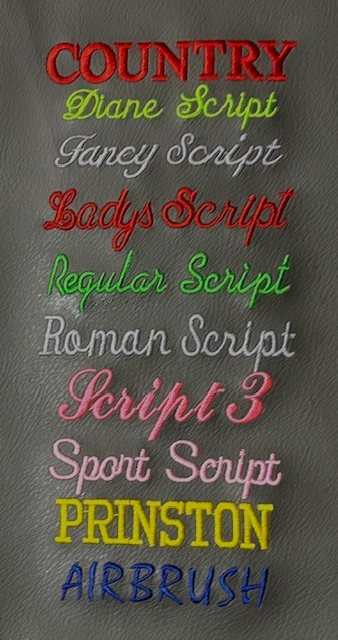Stitched Sports Teams Names and Numbers - Specialist and Sturdy
Stitched Sports Teams Names and Numbers - Specialist and Sturdy
Blog Article
The Art of Custom Embroidery: Unlocking the Tricks to Creating Special and Remarkable Layouts
The tricks to creating custom embroidery designs that captivate the eye and leave a long-term impact lie in a delicate equilibrium of method, creativity, and attention to information. As we dig into the globe of custom-made embroidery, we reveal the nuanced interaction between string choice, stitch intricacy, and style personalization that boosts a simple garment to a work of art.
Selecting the Right Embroidery Threads
When picking embroidery strings, what essential aspects should you consider to guarantee the very best results for your customized layouts? The choice of embroidery thread is critical in identifying the last end result of your embroidered design. One of the main factors to consider is the material of the thread. Different materials such as cotton, polyester, rayon, and silk use differing degrees of sheen, longevity, and texture. It is necessary to choose a string product that enhances the fabric you are embroidering on and aligns with the preferred look of the style.
Thicker strings can add dimension and structure to your style, while finer strings are optimal for intricate details and tiny text. Additionally, thinking about the color fastness and washability of the string is critical to make sure that your custom layouts keep their high quality and vibrancy over time.
Exploring Different Stitch Techniques
To dig into the world of 'Exploring Different Stitch Methods', one need to grasp the details and subtleties that each sewing technique offers the art of embroidery. Various stitch strategies not just add visual interest but also add to the overall texture and measurement of the layout. One prominent stitch technique is the satin stitch, which involves very closely packed parallel stitches to develop a smooth and shiny surface, perfect for filling in shapes and developing bold describes.
On the various other hand, the backstitch is a functional technique usually utilized for outlining and adding fine information. It entails stitching backward to produce a strong line of needlework. In addition, the French knot stitch adds a tactile aspect to styles, excellent for creating textured accents like flower centers or ornamental touches.
Discovering various stitch strategies allows embroiderers to play with light, shadow, and deepness within their layouts, boosting the aesthetic allure and imaginative quality of their embroidery projects. By mastering various stitching methods, one can unlock unlimited opportunities for producing special and remarkable personalized needlework items.
Incorporating Personalized Layout Components
Having actually checked out the complexities of various stitch methods such as the satin stitch, backstitch, and French knot, the focus currently moves towards including tailored style elements in personalized embroidery projects. Individualized design components play a vital role in making needlework jobs truly special and memorable.
Another method to integrate customized style elements is by including signs or concepts that hold special definition to the recipient or show their passions and character. Integrating a favored flower, pet, look these up or hobby-related icon can make the embroidery layout more significant and tailored. Additionally, selecting shades that resonate with the recipient or line up with the desired theme can even more improve the customization of the embroidery job.
Understanding the Art of Shade Coordination

One key aspect of shade coordination is recognizing color theory. This consists of knowing exactly how various colors engage with each various other, the emotions they communicate, and just how they can be integrated to create visually enticing designs. By applying shade concept principles, embroiderers can create unified shade palettes that improve the general look of the style.
In addition, focusing on comparison is crucial in color sychronisation. Making use of contrasting shades can help specific aspects of the layout pop, boost legibility, and produce an aesthetically dynamic needlework item. By mastering the art of shade sychronisation, embroiderers can elevate their styles and create remarkable items that reverberate with clients and audiences alike.
Enhancing Appearance With Advanced Embroidery Stitches
French knots, as an example, are excellent for adding small, increased dots to your style, simulating the appearance of grains or developing a distinctive surface. Bullion knots, on the other hand, can be used to create twisted, ropelike aspects that add an extravagant feeling to the embroidery. Seed stitching involves tiny, scattered stitches that can complete areas with a multicolor structure, while turkey work produces fluffy, dimensional accents reminiscent of tailored shirts online animal fur or foliage. Explore these advanced needlework stitches allows you to push the boundaries of traditional needlework and develop absolutely one-of-a-kind and aesthetically enticing structures in your styles.
Verdict
To conclude, the art of custom-made embroidery entails a mix of selecting the right strings, checking out various stitch strategies, integrating customized layout aspects, mastering shade sychronisation, and enhancing texture with innovative stitches. By comprehending and carrying out these crucial components, embroiderers can produce unique and unforgettable styles that display their imagination and ability. Needlework lovers can open the keys to producing stunning and bespoke pieces that stand out and leave an enduring impression.
Report this page